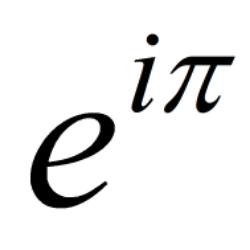边缘检测目的是要检测出图像中灰度变化的不连续区域(2) - 算子
suanzi.ziyouw.cn/v/e/i_2.html
轉為繁體網頁
在二维空间,对应二阶微分有两种算子:Laplace算子和Marr算子。Laplace算子也称拉 .... 详细. (算子杨松编辑整理, 转载请注明出处http://suanzi.ziyouw.cn/v/e/i.html)
为什么 空间二阶导(拉普拉斯算子)这么重要?
《数理方程》课上讲的三类基本方程,方程的一边都是拉普拉斯算符,另一边分别是时间二阶导、一阶导和0,为什么空间二阶导这么重要?它有什么样的数学和物理意义?
13 个回答
本来不觉得这个问题提的好,但是看到这样一个答案:
坐标无关的算子,或者叫内蕴算子,在黎曼几何里由特征值衍生的,是很多的。这不足以解释为什么Laplacian算子为何重要。或者说这个答案指示了一种性质,但是这个性质也不是刻画性质(Characterizing Property),因此我觉得这个答案并没有答到点子上。
另外一个看似合理的答案:
简短的这句话,“从表示论的角度看重要的对象应该是 Casimir elements, 后者与 Laplacians 有自然的类比关系.”我来断一下句,作者的原意应该是Laplacian可以看作是Lie代数上的Casmir元,这在sl^{n}(\mathbb{C})中很显然,但是在更加一般的场合,甚至说gl^{n}(\mathbb{C})就并不显然。而且Casmir元如果我没记错的话主要是用来证对应表示的完全可约性的(complete reducibility,usage by Harris& Wallach),它在gl中,可给定坐标计算,如果它还有更深刻的与Laplacian的联系或者我的理解有不足的地方,请指教。
最合理的解释要用到所谓的Hodge-Laplace理论。浅显地说,我们能够定义一种Hodge*算子,这种算子的定义形式上是这样的:对于至少是浸入(immersed)到某个n维流形里面的p维闭子流形,我们考虑其子外代数上的Hodge*算子:



而Hodge-Laplace算子在给定R^n的典型坐标下可以计算出这确实是传统上定义在Riem流形上的trace(D^2)。然后我们把 的p次微分形式称为p次调和形式。读者最好检查一下这个算子的线性性,因为我宣称这些定义在同一个Riem流形上的p次调和形式全体是实向量空间,记作
的p次微分形式称为p次调和形式。读者最好检查一下这个算子的线性性,因为我宣称这些定义在同一个Riem流形上的p次调和形式全体是实向量空间,记作 。好了,那么为什么要研究这套看似更复杂的语言来刻画简单定义的Laplacian呢?答案是Hodge定理:
。好了,那么为什么要研究这套看似更复杂的语言来刻画简单定义的Laplacian呢?答案是Hodge定理:
上面所说的在于实的状况,但是Hodge理论本身重要性在于研究复流形,就不多讲了。
假如读者有进一步的兴趣,Stein的Harmonic Analysis是一本百科全书,所知道的一定比我更全面。
=====
Hu:我敦促L来写这个答案,很大程度上是因为现在我们似乎需要一些稍微serious的问题,和一些稍微serious的答案。
Zhu:問問題可以local一些,However you should have a global view,觀點有趣也是可以的。
by L
revised by L JiangD Hu Zhu 显示全部
最浅层的答案是,拉普拉斯算子是Coordinate-free的。我觉得有必要更深刻地解答一下。
坐标无关的算子,或者叫内蕴算子,在黎曼几何里由特征值衍生的,是很多的。这不足以解释为什么Laplacian算子为何重要。或者说这个答案指示了一种性质,但是这个性质也不是刻画性质(Characterizing Property),因此我觉得这个答案并没有答到点子上。
另外一个看似合理的答案:
我不熟悉 Laplacian 的分析和几何方面的意义. 但是从表示论的角度看重要的对象应该是 Casimir elements, 后者与 Laplacians 有自然的类比关系.这个也许是一个可能的解释,但是同样不很正确。
简短的这句话,“从表示论的角度看重要的对象应该是 Casimir elements, 后者与 Laplacians 有自然的类比关系.”我来断一下句,作者的原意应该是Laplacian可以看作是Lie代数上的Casmir元,这在sl^{n}(\mathbb{C})中很显然,但是在更加一般的场合,甚至说gl^{n}(\mathbb{C})就并不显然。而且Casmir元如果我没记错的话主要是用来证对应表示的完全可约性的(complete reducibility,usage by Harris& Wallach),它在gl中,可给定坐标计算,如果它还有更深刻的与Laplacian的联系或者我的理解有不足的地方,请指教。
最合理的解释要用到所谓的Hodge-Laplace理论。浅显地说,我们能够定义一种Hodge*算子,这种算子的定义形式上是这样的:对于至少是浸入(immersed)到某个n维流形里面的p维闭子流形,我们考虑其子外代数上的Hodge*算子:
而Hodge-Laplace算子在给定R^n的典型坐标下可以计算出这确实是传统上定义在Riem流形上的trace(D^2)。然后我们把
给定实紧定向Riem流形M,这就直接告诉我们研究上同调,研究调和形式就足够了。为什么这个结果这样漂亮?因为PDE理论可以告诉我们一些调和(算子)方程的优良性质,这是一般的微分方程所不具备的。最简单的就是调和方程的特征函数解法,这直接关系到第一特征值的估计。(实调和p形式)同构于(上同调向量空间)
上面所说的在于实的状况,但是Hodge理论本身重要性在于研究复流形,就不多讲了。
假如读者有进一步的兴趣,Stein的Harmonic Analysis是一本百科全书,所知道的一定比我更全面。
=====
Hu:我敦促L来写这个答案,很大程度上是因为现在我们似乎需要一些稍微serious的问题,和一些稍微serious的答案。
Zhu:問問題可以local一些,However you should have a global view,觀點有趣也是可以的。
by L
revised by L JiangD Hu Zhu 显示全部
最浅层的答案是,拉普拉斯算子是Coordinate-free的。
===================
确切地说,拉普拉斯算子是阶数最低的,从scalar function 到scalar function 的 Coordinate-free的 平移不变的不平庸的算子, up to a factor。
物理研究的对象要求具有平移和旋转的对称性,拉普拉斯算子就是满足这两条的阶数最低的算子。
===================
确切地说,拉普拉斯算子是阶数最低的,从scalar function 到scalar function 的 Coordinate-free的 平移不变的不平庸的算子, up to a factor。
物理研究的对象要求具有平移和旋转的对称性,拉普拉斯算子就是满足这两条的阶数最低的算子。
很多物理量在时空中是守恒的,例如质量、能量和动量,这些物理量在实际过程中应用得非常广泛,比如流体力学、传热学、传质学、电磁场等等,在控制体中描述这些物理量流入和流出的方法最方便的就是散度了,求散度的方法就是对这个物理量使用拉普拉斯算子,拉普拉斯算子就是对空间求二阶导啦
匿名用户、玄清少主、Lance Cotton 等人赞同
很好的问题.
我不熟悉 Laplacian 的分析和几何方面的意义. 但是从表示论的角度看重要的对象应该是 Casimir elements, 后者与 Laplacians 有自然的类比关系.
MO 上也有一些讨论: http://mathoverflow.net/questions/54986/why-is-the-laplacian-ubiquitous
我不熟悉 Laplacian 的分析和几何方面的意义. 但是从表示论的角度看重要的对象应该是 Casimir elements, 后者与 Laplacians 有自然的类比关系.
MO 上也有一些讨论: http://mathoverflow.net/questions/54986/why-is-the-laplacian-ubiquitous
好像很多物理现象最后的数学描述都是拉普拉斯方程或者双调和方程。作为力学生,我只说说在力学里面的一些东西:流体力学中速度势和流势都满足拉普拉斯方程;弹性力学中平面问题的艾里应力函数满足的是双调和方程……除了很多物理现象的数学描述的最后形式是拉普拉斯方程外,在拉普拉斯方程出现的初期,数学家们由这个方程推出了很多重要的函数:贝塞尔函数,勒让德函数等等。反正在我看来吧,拉普拉斯方程真挺重要的。
并没有什么特别的东西。
数理方程 是将物理中的一些形式接近的方程放在一块,一起讲,免得每次上课的时候都需要讲如何解这类方程。
比如说,
你在坐标表象下解薛定谔绘景的时候,哈密顿量中就有拉普拉斯算子。。
电动力学中, B 和 E 消去一个之后就是 拉普拉斯算子。
扩散方程振动方程 这类方程的都会带有拉普拉斯算子。
数理方程 是将物理中的一些形式接近的方程放在一块,一起讲,免得每次上课的时候都需要讲如何解这类方程。
比如说,
你在坐标表象下解薛定谔绘景的时候,哈密顿量中就有拉普拉斯算子。。
电动力学中, B 和 E 消去一个之后就是 拉普拉斯算子。
扩散方程振动方程 这类方程的都会带有拉普拉斯算子。
匿名用户、匿名用户、知乎用户 赞同
这三类方程是最简单的双曲、抛物和椭圆方程,一般来说越简单的越容易被我们观察到,因此出现的更多(多少有点人择原理的感觉。。。。),比如场论(粒子)里面基本上都是极小耦合。
--------
补充几句,
二阶方程的初始条件或者边界条件是容易具有明确的物理意义的,零阶是位置,一阶是动量,一般性的物理经验是这两个条件确定时系统的演化是确定的。高阶导数出现时需要根据具体的问题具体讨论。
波动方程的物理意义是场位形扰动在空间的传播,并且波包不会衰减。波动方程具有Lorentz协变性,因此只需要波源和接收者两者的相对位置和运动关系即可确定物理实在。
扩散方程或者叫热方程,后面你还会学到复的Schrodinger方程,也具有“传播”的性质,但这时波包一定会随时间散开。扩散方程不具有Lorentz或者Galileo协变性,因此物理实在是随参考系的选择而表现不同的,所以需要波源和接收者相对背景参考系一起确定。
Laplace方程描述稳态(没有时间嘛),物理意义比如电势能,Newton引力势能,稳定的温度场等等,这个可以这样想:考虑一个布满空间的格点,相邻的格点由同一种轻弹簧连接,格点之间的距离是弹簧的平衡距离,现在假设格点被同种质点代替,质点可以移动,边界条件确定了边界上质点的位置,那么这时整个弹簧质点系统的稳定位置,当格点间距趋向于零时,就是Laplace方程的解。所以一般来说Laplace算子是场内部弹性势能的响应。(叙述的太啰嗦了- -,一般好一点的教材应该会讲吧)
这些物理意义从拉氏量和格林函数的角度可以直接看出来,所以学习数学物理方法这两个话题一定要好好学!(有些老师会略讲这些)
对维数的依赖。
量子化后还要考虑可重整性,系统的自恰性(反常的出现),对规范对称性的保持,等等,一般来说这些可以剔除掉高阶微分算子。以后补充(实际上是编不下去了,谁来写个靠谱的答案= =)
--------
补充几句,
二阶方程的初始条件或者边界条件是容易具有明确的物理意义的,零阶是位置,一阶是动量,一般性的物理经验是这两个条件确定时系统的演化是确定的。高阶导数出现时需要根据具体的问题具体讨论。
波动方程的物理意义是场位形扰动在空间的传播,并且波包不会衰减。波动方程具有Lorentz协变性,因此只需要波源和接收者两者的相对位置和运动关系即可确定物理实在。
扩散方程或者叫热方程,后面你还会学到复的Schrodinger方程,也具有“传播”的性质,但这时波包一定会随时间散开。扩散方程不具有Lorentz或者Galileo协变性,因此物理实在是随参考系的选择而表现不同的,所以需要波源和接收者相对背景参考系一起确定。
Laplace方程描述稳态(没有时间嘛),物理意义比如电势能,Newton引力势能,稳定的温度场等等,这个可以这样想:考虑一个布满空间的格点,相邻的格点由同一种轻弹簧连接,格点之间的距离是弹簧的平衡距离,现在假设格点被同种质点代替,质点可以移动,边界条件确定了边界上质点的位置,那么这时整个弹簧质点系统的稳定位置,当格点间距趋向于零时,就是Laplace方程的解。所以一般来说Laplace算子是场内部弹性势能的响应。(叙述的太啰嗦了- -,一般好一点的教材应该会讲吧)
这些物理意义从拉氏量和格林函数的角度可以直接看出来,所以学习数学物理方法这两个话题一定要好好学!(有些老师会略讲这些)
对维数的依赖。
量子化后还要考虑可重整性,系统的自恰性(反常的出现),对规范对称性的保持,等等,一般来说这些可以剔除掉高阶微分算子。以后补充(实际上是编不下去了,谁来写个靠谱的答案= =)
二阶导为什么重要呢?因为二阶导是曲率。
entropy crowd ∇ Nabla operator or gradient to turn a "landscape" into a directed force (a force field). T is a kind of temperature, that defines the overall strength (available resources) the intelligent system has (heat can do work, think of a steam engine: the more heat the more power). Sτ is the "freedom of action" of each state that can be reached by the intelligence within a time horizon τ (tau).
△二次函数根的判别式或者指三角形
▽读Nabla,奈不拉,也可以读作“Del” 这是场论中的符号,是矢量微分算符。 高等数学中的梯度,散度,旋度都会用到这个算符。 其二阶导数中旋度的散度又称Laplace算符
标签:
杂谈
▽ 是梯度算子(在空间各方向上的全微分),
△二次函数根的判别式或者指三角形 ▽读Nabla,奈不拉,也可以读作“Del” 这是场论中的符号,是矢量微分算符。 高等数学中的梯度,散度,旋度都会用到这个算符。 其二阶导数中旋度的散度又称Laplace算符
梯度
1 散度 δP/δx + δQ/δy + δR/δz 叫做向量场 A 的散度,记作 div A,即 div A = δP/δx + δQ/δy + δR/δz 2 梯度 在二元函数的情形,设函数z=f(x,y)在平面区域D内具有一阶连续偏导数,则对于每一点P(x,y)∈D,都可以定出一个向量 (δf/x)*i+(δf/y)*j 这向量称为函数z=f(x,y)在点P(x,y)的梯度,记作gradf(x,y) 类似的对三元函数也可以定义一个:(δf/x)*i+(δf/y)*j+(δf/z)*k 记为grad[f(x,y,z)]
i,j是方向
标签: 杂谈 |
△二次函数根的判别式或者指三角形 ▽读Nabla,奈不拉,也可以读作“Del” 这是场论中的符号,是矢量微分算符。 高等数学中的梯度,散度,旋度都会用到这个算符。 其二阶导数中旋度的散度又称Laplace算符
梯度
1 散度 δP/δx + δQ/δy + δR/δz 叫做向量场 A 的散度,记作 div A,即 div A = δP/δx + δQ/δy + δR/δz 2 梯度 在二元函数的情形,设函数z=f(x,y)在平面区域D内具有一阶连续偏导数,则对于每一点P(x,y)∈D,都可以定出一个向量 (δf/x)*i+(δf/y)*j 这向量称为函数z=f(x,y)在点P(x,y)的梯度,记作gradf(x,y) 类似的对三元函数也可以定义一个:(δf/x)*i+(δf/y)*j+(δf/z)*k 记为grad[f(x,y,z)]
i,j是方向 物理学计算中经常出现一个正三角或倒三角,是什么算符?_ ...
wenda.tianya.cn/question/5790b391daa8e85b
轉為繁體網頁
2009年8月14日 - 正三角形是在高中物理上经常出现的一个符号,它是希腊字母,读作:delta,它表示的是某个物理量的变化。例如: Δv=v2-v1. Δt=t2-t1 而倒三角形是在高等 ...
wenda.tianya.cn/question/5790b391daa8e85b
轉為繁體網頁
2009年8月14日 - 正三角形是在高中物理上经常出现的一个符号,它是希腊字母,读作:delta,它表示的是某个物理量的变化。例如: Δv=v2-v1. Δt=t2-t1 而倒三角形是在高等 ...轉為繁體網頁
Volatility and the Square Root of Time
Friday, April 17th, 2015 | Vance Harwood
It’s not obvious (at least to me) that volatility theoretically scales with the square root of time (sqrt[t]). For example if the market’s daily volatility is 0.5%, then the volatility for two days should be the square root of 2 times the daily volatility (0.5% * 1.414 = 0.707%), or for a 5 day stretch 0.5% * sqrt(5) = 1.118%.
This relationship holds for ATM option prices too. With the Black and Scholes model if an option due to expire in 30 days has a price of $1, then the 60 day option with the same strike price and implied volatility should be priced at sqrt (60/30) = $1 * 1.4142 = $1.4142 (assuming zero interest rates and no dividends).
VIX is not your typical indexWhen an index provider starts calculating a new index, they will choose a starting point, a base level. This can be any number — 100, 1000, or even a million. Investors correctly don’t pay much attention to that. It’s the percentage changes in this index, driven by the increases and decreases in value of the securities it comprises, which are of most value to the market.
In the case of VIX, movements up and down are important as well. However, the actual VIX level means something too. It communicates the 30-day implied volatility of the S&P 500. In a previous post, I explained what this means.
But how can we arrive at the 30-day implied volatility? How do we convert the current VIX level into this information? This isn’t hard, but it does require some simple math. Here are the two steps.
You may wonder why we would divide by the square root of 12. My advice is to put this deep question aside and to concentrate on the basics. For now, it is sufficient to know that you can back out the 30-day implied volatility from the VIX level with this simple formula.
Understanding what “volatility” is in the context of VIXThe implied 30-day volatility of the S&P 500 tells you the likely range of possible index levels the market “expects” in a month. If the implied 30-day volatility is 4.3% — which equates a VIX level of 15 — then this means that the market expects the index to have a return that is within a range that spans 4.3% higher and 4.3% lower than the index level.*
We say “expects” because the market isn’t sure and is instead communicating what will probably happen. You will remember from your basic statistics courses that when someone brings up probability, a bell curve soon follows. This blog post is no exception.
Below is a normal distribution, the most common type of probability distribution that supposes that most data points will fall near the average. On this type of curve, one standard deviation comprises about 68% of likely outcomes. In our case, the data points in the bell curve are possible index levels the S&P 500 could arrive at 30 days from now. The 30-day implied “volatility” that VIX conveys is one standard deviation in the bell curve, which is centered on the index level.
Putting this knowledge into practiceNow that you know the basics, let’s use them. Assume that today, the S&P 500 level is 1710 and the VIX level is 18. What additional information can you extract from these two data points?
As a first step, turn the VIX level into the 30-day implied volatility:
Turn VIX into a percentage: VIX = 18 = 18%
Then deannualize it: 18% / √12 = 5.20%
Second, apply this percentage to the index level:
1710 x 5.20% ≈ 89
Third, subtract and add this amount to the index level to tell you the range the market expects the S&P 500 to trade in 30 days from now, with a 68% confidence level:
1710 + 89 = 1799
1710 – 89 = 1621
The range between these numbers, 1621 to 1799, is where the market expects the S&P 500 to trade in 30 days, with a reasonably high level of confidence. You may agree or disagree with this, but this is what the market believes, and this is a powerful starting point around which to build an investment strategy.
* Using the current index level is a helpful shortcut. In reality, the probability curve is centered around the forward price of the index, which is the current index level adjusted for various payments the investor hypothetically might have received or lost, including interest, dividends, and income from stock lending. Making these adjustments matters less if you are only looking ahead a short time and if interest rates and dividends are low.
- See more at: http://www.indexologyblog.com/2013/10/18/turn-vix-into-information-you-can-use/#sthash.Wydld9jm.dpuf
This relationship holds for ATM option prices too. With the Black and Scholes model if an option due to expire in 30 days has a price of $1, then the 60 day option with the same strike price and implied volatility should be priced at sqrt (60/30) = $1 * 1.4142 = $1.4142 (assuming zero interest rates and no dividends).
Free Will and the Square Root of Entropy | Multisense Realism
multisenserealism.com/2013/12/.../free-will-and-the-square-root-of-entropy...
Dec 1, 2013 - This view introduces a new factor, the square root of Entropy (√H). If the universe is founded on pansensitivity or Sense (-ℵ), then the initial ...Category-Theoretic Characterizations of Entropy III | The n ...
https://golem.ph.utexas.edu/.../categorytheo...
Jun 5, 2011 - I strongly suspect that the square root of entropy does not satisfy the triangle inequality. It can't be that hard, and if it were true I think David or ...
University of Texas at Austin
Loading...
Just-Dice.com : Invest in 1% House Edge Dice Game
https://bitcointalk.org/index.php?topic=242962.2565;...
Can anyone help me justify why stdev would be the square root of entropy? Your visualization shows him pretty much riding the 2 sigma line most of the way, no ...
Bitcoin Forum
Loading...
Marton : Measure concentration for Euclidean distance in ...
https://projecteuclid.org/euclid.aop/1264434004
Project Euclid
Loading...
by K Marton - 2010 - Cited by 3 - Related articles
We correct an error in the paper identified in the title. The error affects the factor before the square root of entropy in Theorem 1; the same factor appears in ...$BLUE out the last of my shares here. $3 bounce off lows. It was just a day trade. So +$570 in whole trade. Wish I covered balance lower
Turn VIX into information you can use
2 Comments »
Most people think of VIX as simply an index. This makes sense — the “I” in VIX stands for that very word. But VIX is more useful than your average index. It could easily be grouped with economic indicators, like the unemployment percentage or new home sales. Why? Because the VIX level — not just the changes in that level — contains valuable information. In this post I will show you how, with some high school math, you can extract this information and arm yourself with knowledge that will inform your investment decisions.VIX is not your typical indexWhen an index provider starts calculating a new index, they will choose a starting point, a base level. This can be any number — 100, 1000, or even a million. Investors correctly don’t pay much attention to that. It’s the percentage changes in this index, driven by the increases and decreases in value of the securities it comprises, which are of most value to the market.
In the case of VIX, movements up and down are important as well. However, the actual VIX level means something too. It communicates the 30-day implied volatility of the S&P 500. In a previous post, I explained what this means.
But how can we arrive at the 30-day implied volatility? How do we convert the current VIX level into this information? This isn’t hard, but it does require some simple math. Here are the two steps.
- Turn the VIX level into a percentage. So, a VIX level of 15 equates 15%. This is the annualized implied 30-day volatility for the S&P 500.
- Deannualize VIX to turn it back into its true monthly measure. The formula for this is to divide the VIX level, as a percentage, by the square root of 12, the number of months in a year.
You may wonder why we would divide by the square root of 12. My advice is to put this deep question aside and to concentrate on the basics. For now, it is sufficient to know that you can back out the 30-day implied volatility from the VIX level with this simple formula.
Understanding what “volatility” is in the context of VIXThe implied 30-day volatility of the S&P 500 tells you the likely range of possible index levels the market “expects” in a month. If the implied 30-day volatility is 4.3% — which equates a VIX level of 15 — then this means that the market expects the index to have a return that is within a range that spans 4.3% higher and 4.3% lower than the index level.*
We say “expects” because the market isn’t sure and is instead communicating what will probably happen. You will remember from your basic statistics courses that when someone brings up probability, a bell curve soon follows. This blog post is no exception.
Below is a normal distribution, the most common type of probability distribution that supposes that most data points will fall near the average. On this type of curve, one standard deviation comprises about 68% of likely outcomes. In our case, the data points in the bell curve are possible index levels the S&P 500 could arrive at 30 days from now. The 30-day implied “volatility” that VIX conveys is one standard deviation in the bell curve, which is centered on the index level.
Putting this knowledge into practiceNow that you know the basics, let’s use them. Assume that today, the S&P 500 level is 1710 and the VIX level is 18. What additional information can you extract from these two data points?
As a first step, turn the VIX level into the 30-day implied volatility:
Turn VIX into a percentage: VIX = 18 = 18%
Then deannualize it: 18% / √12 = 5.20%
Second, apply this percentage to the index level:
1710 x 5.20% ≈ 89
Third, subtract and add this amount to the index level to tell you the range the market expects the S&P 500 to trade in 30 days from now, with a 68% confidence level:
1710 + 89 = 1799
1710 – 89 = 1621
The range between these numbers, 1621 to 1799, is where the market expects the S&P 500 to trade in 30 days, with a reasonably high level of confidence. You may agree or disagree with this, but this is what the market believes, and this is a powerful starting point around which to build an investment strategy.
* Using the current index level is a helpful shortcut. In reality, the probability curve is centered around the forward price of the index, which is the current index level adjusted for various payments the investor hypothetically might have received or lost, including interest, dividends, and income from stock lending. Making these adjustments matters less if you are only looking ahead a short time and if interest rates and dividends are low.
Volatility Index (VIX) [ChartSchool] - StockCharts.com
stockcharts.com/school/doku.php?id=chart_school...volatility_index
The volatility indices measure the implied volatility for a basket of put and call options ... A daily number would be found by dividing by the square root of 252 ... VIX levels with the expected volatility in the S&P 500 on a monthly or daily basis.
The resulting VIX provides us with the weighted 30-day standard deviation of annual movement in the S&P 500. A reading of 20% would expect a 20% move, up or down, in the next 12 months. This annualized number can be transformed into a monthly number by dividing it by the square root of 12 (~3.464). A daily number would be found by dividing by the square root of 252 (~15.874), which is the number of trading days in a year. The table below shows VIX levels with the expected volatility in the S&P 500 on a monthly or daily basis. Keep in mind that we are talking about volatility, not the expected return or change.
最小作用量 ... 因此我们说,分布函数是关于力学不变量的函数。我们选择能量就成为 ...
^/1一%=一mc癣(4) ~ C' 质点动量1一曲一劬一廊。 p一照 ...
...
函数,将保守系统的四 ... 从数学角度看:(2)式给出的作用量是定义于集{L(q,q,t)}上的泛函.
是整个系统的平均消息量,即: ... 其中s是作用量,ψ是波函数。 )
磁性材料-第七章_百度文库
、磁制冷实现的过程(1)等温磁化过程(2)绝热去磁过程(3)等温 ...
不是说计算参数,而是计算后的结果,比如德拜温度曲线、熵、焓、热 ...
Describing intelligence as a physical force that maximises the future freedom of action, adds a new aspect to intelligence that is often forgotten: the power to change the world. This, I think, was the biggest revelation for me, when I started thinking about the the new equation for intelligence. The second revelation was, that intelligent systems are survival engines, that increase their chances of survival by maximising a single quantity: the freedom of action. Both insights may sound trivial or obvious, but I don't think they are.
A few days ago a saw the TED talk "A new equation for intelligence" by Alex Wissner-Gross. He presents an equation he published in April 2013 in a physics journal. It may not be the most impressive talk I have ever seen. And I had to watch it twice to fully understand it. But the message excites me so much, that I don't sleep well since a few days. I thought everybody must be excited about this equation. But, it seems that this is not the case. Either I am not understanding it correctly or others don't get it. Or maybe it resonates with me, because I am physicist, with a strong background in computing, who has done research in computational biology. To find this out, let me explain my understanding of the equation. Please tell what your think and what's wrong with my excitement (I need sleep)....
So, why did the equation blow me away? Because this very simple physical equation can guide us in our decisions and it makes intelligent behaviour measurable and observable. It adds a new real physical force to the world, the force of intelligence. From the equation we can deduce algorithms to act intelligently, as individuals, as societies and as mankind. And we can build intelligent machines using the equation. Yes, I know, you may ask: "How can the simple equation F = T ∇ Sτ do all of that?"
统计物理学中的“最小作用量原理” - 心情随笔网
www.huangi.com/article/75283596824/
轉為繁體網頁
经典力学中力学系统的运动规律的最一般表述由“最小作用量原理”给出。我觉得,“轉為繁體網頁
关于最小作用量原理2_百度文库
wenku.baidu.com/view/b3c737fd700abb68a982fbc2.html - 轉為繁體網頁
2010年12月12日 - 物理学关于最小作用量原理刘大为(甘肃联合大学理工学院, ... 作用量函数L=一mc作用量,熵(体系,理想氣體)狀態函數,路徑無關;最小作用量原理 ...
blog.sina.com.cn/s/blog_a582cd40010178x9.html
轉為繁體網頁
2012年7月18日 - 作用量狀態函數 的結果(無引號): ... 薛定谔是一个聪明人,他知道这个世界上,孤立体系熵是增加的(也就是说,孤立 ... 其中s是作用量,ψ是波函数。轉為繁體網頁
熵- 维基百科,自由的百科全书
https://zh.wikipedia.org/zh-hk/熵
熵亦被用於計算一個系統中的失序現象,也就是計算該系統混亂的程度。熵是一个描述系统状态的函数,但是经常用熵的参考值和变化量进行分析比较,它在控制论、关于最小作用量原理_CNKI学问
xuewen.cnki.net/CJFD-KXJS200710032.html - 轉為繁體網頁
关于最小作用量原理-1对于三种基本原理目前被认知的普遍程度的评述任何自然事物的变化 ... 沿用普通分析力学中的研究思路,引入两个新广义动量和新Hamil-ton标度,对数,熵,概率,信息,最小作用量- ideaflying的日志 ...
ideaflying.blog.163.com/.../23536005220149610105188...
轉為繁體網頁
2014年10月6日 - Nottale的标度相对论主要分成两大块,一块是纯粹的相对论,他仿照爱因 ... 信息熵轉為繁體網頁
稳定作用量原理_搜索_互动百科
www.baike.com/wiki/稳定作用量原理 - 轉為繁體網頁
稳定作用量原理,互动百科搜索. ... 周向作用量_百科词条. 是指,当波流同向时,波变平缓;当波流反向时,波明显变陡.随着波流强度的增加,非线性的 ... 作用量作额外的限制。我们假设S[φ]是M上的如下函数的积分称为拉格朗日量,它. ... 熵量守恒定律 ...万门大学|新闻|[万门大学杯]第一届理论物理知识竞赛
www.wanmen.org/blogs/36
轉為繁體網頁
系统的拉氏量L可以减去“任意函数f对时间的全导数”而不改变其物理演化。 2. 场论中的作用量密度L是t,x,y,z的函数,经典力学中的作用量是t的函数. 3. 四维磁矢势A ...轉為繁體網頁
磁性材料-第七章_百度文库
wenku.baidu.com/view/16bcacd96f1aff00bed51eb5.html?...
轉為繁體網頁
2011年6月10日 - ?Tad ad 比热容测量法:磁比热~温度曲线?熵~温度曲线? ?T ?S M 7.2 磁制冷技术1轉為繁體網頁
学生用材料科学基础第6章_中华文本库
www.chinadmd.com/.../w6ucevarowcaieueosxprrp6_1.ht...
轉為繁體網頁
... 相起伏就是晶核的胚芽,称为晶胚。 rmax 过冷度△T. 6.2.2. 晶体凝固的热力学条件. 一、自由能和温度曲线熵的物理意义是表征系统中原子排列混乱程度的参数。轉為繁體網頁
对合金进行声子计算,用Linear response法好,还是用Finite ...
emuch.net/html/201309/6360015.html
轉為繁體網頁
轉為繁體網頁
2013年9月13日 - 15 篇文章 - 5 位作者
我在开头已经说过了,做的是镍基合金另外我有一点没说清,我说要重新找资料,A new Equation for Intelligence F = T ∇ Sτ - a Force that Maximises the Future Freedom of Action
Intelligence is a Force with the Power to Change the World
Describing intelligence as a physical force that maximises the future freedom of action, adds a new aspect to intelligence that is often forgotten: the power to change the world. This, I think, was the biggest revelation for me, when I started thinking about the the new equation for intelligence. The second revelation was, that intelligent systems are survival engines, that increase their chances of survival by maximising a single quantity: the freedom of action. Both insights may sound trivial or obvious, but I don't think they are.
A few days ago a saw the TED talk "A new equation for intelligence" by Alex Wissner-Gross. He presents an equation he published in April 2013 in a physics journal. It may not be the most impressive talk I have ever seen. And I had to watch it twice to fully understand it. But the message excites me so much, that I don't sleep well since a few days. I thought everybody must be excited about this equation. But, it seems that this is not the case. Either I am not understanding it correctly or others don't get it. Or maybe it resonates with me, because I am physicist, with a strong background in computing, who has done research in computational biology. To find this out, let me explain my understanding of the equation. Please tell what your think and what's wrong with my excitement (I need sleep)....
So, why did the equation blow me away? Because this very simple physical equation can guide us in our decisions and it makes intelligent behaviour measurable and observable. It adds a new real physical force to the world, the force of intelligence. From the equation we can deduce algorithms to act intelligently, as individuals, as societies and as mankind. And we can build intelligent machines using the equation. Yes, I know, you may ask: "How can the simple equation F = T ∇ Sτ do all of that?"
Intelligence is a Force that Maximises the Future Freedom of Action
Before we look at the equation in more detail, let me describe its essence in every day terms. Like many physical laws or equations the idea behind it is simple:- Intelligence is a force that maximises the future freedom of action.
- It is a force to keeps options open.
- Intelligence doesn't like to be trapped.
The new Equation for Intelligence F = T ∇ Sτ
Note: skip this section, if you are not interested in understanding the mathematics of the equation!
This is the equation:
This is the equation:
F = T ∇ Sτ
Where F is the force, a directed force (therefore it is bold), T is a system temperature, Sτ is the entropy field of all states reachable in the time horizon τ (tau). Finally, ∇ is the nabla operator. This is the gradient operator that "points" into the direction of the state with the most freedom of action. If you are not a physicist this might sound like nonsense. Before I try to explain the equation in more detail, let's look at a another physical equation of force.
The intelligence equation very similar to the equation for potential energy F = ∇ Wpot. Wpot is the potential energy at each point is space. The force F pulls into the direction of lower energy. This is why gravitation pulls us in direction of the center of the earth. Or think of a landscape. At each point the force points downhill. The direction is the direction a ball would roll starting at that point. The strength of the force is determined by the steepness of the slope. The steeper the slope, the stronger the force. Like the ball is pulled downhill by the gravitational force to reach the state with the lowest energy, an intelligent system is pulled by the force of intelligence into a future with lowest number of limitations. In physics we use the ∇ Nabla operator or gradient to turn a "landscape" into a directed force (a force field).
Where F is the force, a directed force (therefore it is bold), T is a system temperature, Sτ is the entropy field of all states reachable in the time horizon τ (tau). Finally, ∇ is the nabla operator. This is the gradient operator that "points" into the direction of the state with the most freedom of action. If you are not a physicist this might sound like nonsense. Before I try to explain the equation in more detail, let's look at a another physical equation of force.
The intelligence equation very similar to the equation for potential energy F = ∇ Wpot. Wpot is the potential energy at each point is space. The force F pulls into the direction of lower energy. This is why gravitation pulls us in direction of the center of the earth. Or think of a landscape. At each point the force points downhill. The direction is the direction a ball would roll starting at that point. The strength of the force is determined by the steepness of the slope. The steeper the slope, the stronger the force. Like the ball is pulled downhill by the gravitational force to reach the state with the lowest energy, an intelligent system is pulled by the force of intelligence into a future with lowest number of limitations. In physics we use the ∇ Nabla operator or gradient to turn a "landscape" into a directed force (a force field).
Back to our equation F = T ∇ Sτ. What it says is that intelligence is a directed force F that pulls into the direction of states with more freedom of action. T is a kind of temperature, that defines the overall strength (available resources) the intelligent system has (heat can do work, think of a steam engine: the more heat the more power). Sτ is the "freedom of action" of each state that can be reached by the intelligence within a time horizon τ (tau). The time horizon is how far into future the intelligence can predict. Alex Wissner-Gross uses the notion of entropy S to express the freedom of action in the future. The force of intelligence is pointing into that direction. As we have seen, in physics the direction of the force at each state is calculated by a gradient operation ∇ (think of the direction the ball is pulled). The Nabla operator ∇ is used to assign a directional vector (the direction of the force of intelligence) to each state (in our case: all possible future states). The more freedom of action a state provides the stronger the force is pulling in that direction. So, ∇Sτ is the pointing into the direction with the most freedom of action. The multiplication with T means the more power we have to act, the stronger the force can be.
Note: the optimal future state is the optimal state form the viewpoint of the intelligent system. It might not the optimal state for other systems or for the entire system.
If you want to understand the equation in more detail read the original paper 'Causal Entropic Forces - by A. D. Wissner-Gross and C. E. Freer'.
Understanding the Laplace operator conceptually
The Laplace operator: those of you who now understand it, how would you explain what it "does" conceptually? How do you wish you had been taught it?
Any good essays (combining both history and conceptual understanding) on the Laplace operator, and its subsequent variations (e.g. Laplace-Bertrami) that you would highly recommend? | |||||||||||||
|
The Laplacian
and integrate: The integrals where The Laplace-Beltrami operator is essentially the same thing in the more general Riemannian setting - all the nasty curvy terms will be higher order, so the same formula should hold. | |||||||||||||
|
I think the most important property of the Laplace operator
Some good books on the subject:
| |||||||||||||||||||||
|
To gain some (very rough) intuition for the Laplacian, I think it's helpful to think of the Laplacian on
Just as Anthony's answer discusses, the second derivative at Generally, a function is harmonic if and only if it satisfies the mean value property. In The maximum principle states roughly that if Finally, let me go up one dimension and mention some of my intuition for harmonic functions | |||
Another view along the lines of the answers above:
Suppose you have some region in the plane What does "as smooth as possible" mean? Well, one measure of the smoothness of How do we minimize
| |||||
|
Here is some intuition:
I think the most basic thing to know about the Laplacian Notice that the integration by parts formula can be interpreted as telling us that |









